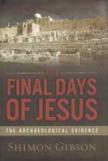The Gospel Truth
Each year at Easter time, one of the news magazines will feature a cover story on Jesus, taking advantage of reader interest as Christians remember Jesus’ death and resurrection. The publication date for Gibson’s book suggests that HarperOne is imitating that marketing strategy. Gibson is a professor of archaeology at the University of North Carolina in Charlotte and has considerable field experience in Israel. His goal is to examine the historical Jesus, using the results of excavations as primary evidence, but the bulk of the book derives its information from ancient texts like the Gospels and the writings of Josephus rather than the findings of archaeology. (Gibson admits that “the Gospels are the main source of information we have for the final week in the life of Jesus.”)
The problem with using literary evidence to reconstruct Jesus’ final days is that the ancient writers do not provide the kind of detail that makes it possible to draw firm historical conclusions. One example is the location of Jesus’ trial before Pilate, the subject of the book’s fifth chapter. The path of the Via Dolorosa that pilgrims walk in Jerusalem today assumes that Jesus’ trial took place in the Antonia Fortress, a military barracks built by Herod the Great at the northeastern edge of the platform on which the Temple stood. Pilate’s residence was in Caesarea Maritima. When he came to Jerusalem, it is unlikely—though not impossible—that he stayed in a barracks. He probably stayed in the Herodian Palace, but the evidence that is adduced to support this conclusion comes from Philo and Josephus and not from archaeology. Gibson asserts that Jesus’ trial took place at the Herodian palace, but there is nothing in the archaeological record to support this assertion.
Gibson also weighs in on the question of the location of Jesus’ tomb. Though the Garden Tomb located outside the Old City of Jerusalem remains a popular site for evangelical pilgrims, there is a general consensus that Jesus’ tomb is located within the Church of the Holy Sepulchre. But this conclusion is not based on archaeological evidence so much as on the pre-Constantinian tradition about the location of Jesus’ tomb. Gibson notes correctly that there are other tombs in close proximity to the structure venerated as the tomb of Christ and suggests that Joseph and Mary were buried in one of those tombs. There is absolutely no textual or archaeological evidence to support this speculation. Still, that a professional archaeologist is making such an assertion gives it a scientific veneer despite the lack of evidence.
Given the book’s subtitle, readers would expect Gibson to deliver evidence. If one had only the archaeological record of first-century Jerusalem to go by, one would not even know that Jesus existed. Jesus left behind no monumental structures or inscriptions etched into stone. There are no material remains that can be unequivocally linked to Jesus. Though the tradition identifying the location of Jesus’ tomb is early, the tomb itself bears no evidence of having been the resting place of Jesus’ body. The value of relics such as the true cross derives from the veneration of many generations of believers—again, not from archaeology.
Archaeology cannot help in reconstructing what happened during Jesus’ final days in Jerusalem. The best it can do is re-create the world of first-century Jerusalem on the basis of the material remains left behind by the city’s inhabitants. The results of scientific excavations have expanded our knowledge of the world in which Jesus, his disciples and his opponents lived. Archaeology has illumined the physical setting of the Jerusalem Jesus visited. Still, what we know of Jesus’ final days comes from the literary record—principally from the four Gospels.
In his trial before Pilate, Jesus explains that his kingdom is “not of this world” (Jn 18:36). Herod the Great and the Roman occupiers of first-century Jerusalem left a lasting imprint on the city. Excavations have uncovered the impressive scale of their building activities. Jesus, by way of contrast, left nothing behind except a message—a powerful message that has transformed the world. It is our fascination with his message that impels us to want to know more about Jesus of Nazareth, and so we turn to archaeology for answers. We should not ask archaeology, however, to do more than it can. Over the past 100 years of excavations in and near Jerusalem, our knowledge of the ancient city and its inhabitants has grown greatly, but it has yielded nothing on the final days of Jesus.
This article also appeared in print, under the headline “The Gospel Truth,” in the June 22, 2009, issue.








